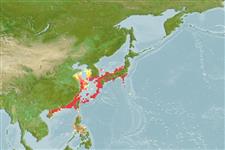Environment: milieu / climate zone / depth range / distribution range
Sinh thái học
Biển Cùng sống ở rạn san hô; Mức độ sâu 10 - 50 m (Ref. 5222). Tropical; 39°N - 12°N, 110°E - 143°E (Ref. 5222)
Northwest Pacific: Korea, Japan, Taiwan, China, Viet Nam, and islands in the South China Sea.
Length at first maturity / Bộ gần gũi / Khối lượng (Trọng lượng) / Age
Maturity: Lm ?, range 16 - ? cm
Max length : 60.0 cm TL con đực/không giới tính; (Ref. 5222); common length : 30.0 cm TL con đực/không giới tính; (Ref. 9137)
Các tia vây lưng cứng (tổng cộng): 11; Các vây lưng mềm (tổng cộng): 15-16; Tia cứng vây hậu môn 3; Tia mềm vây hậu môn: 8. Distinguished by the following characteristics: head and body pale greyish brown dorsally, usually golden yellow ventrally; 4 broad dark bars on the dorsal part of the body, one on caudal peduncle and another often visible on nape; numerous small yellow spots on head and body; body and median fins with small greyish white spots; soft dorsal and caudal fins and sometimes the anal fin, with prominent yellow margin; dusky yellow paired fins; yellow mustache in the maxillary groove; body depth 2.7-3.3 times in SL; head length 2.3-2.6 times in SL; convex interorbital area; strongly convex dorsal head profile; subangular preopercle, 2-5 strong spines at the angle; upper edge of operculum straight, uppermost spine rudimentary; maxilla reaches about to vertical at rear edge of eye; 2 rows of small, subequal teeth on midlateral part of lower jaw; caudal fin convex; lateral body scales distinctly ctenoid, with auxiliary scales in fish larger than 30 cm SL; pyloric caeca 12, in 3 bundles (Ref. 089707).
Occurs in rocky areas as well as on sandy-mud bottoms. Juveniles are common in tide pools. In captivity, the species is aggressive, chasing and biting other species, especially members of its own species. Protogynous hermaphrodite (Ref. 5222). Artificial fertilization of eggs was done and the longest survival time for the larvae was 15 days (Ref. 6780). In Hong Kong live fish markets (Ref. 27253).
Heemstra, P.C. and J.E. Randall, 1993. FAO Species Catalogue. Vol. 16. Groupers of the world (family Serranidae, subfamily Epinephelinae). An annotated and illustrated catalogue of the grouper, rockcod, hind, coral grouper and lyretail species known to date. Rome: FAO. FAO Fish. Synop. 125(16):382 p. (Ref. 5222)
IUCN Red List Status (Ref. 130435)
Threat to humans
Harmless
Human uses
Các nghề cá: Tính thương mại; Nuôi trồng thủy sản: Tính thương mại
Các công cụ
Special reports
Download XML
Các nguồn internet
Estimates based on models
Preferred temperature (Ref.
123201): 16.2 - 25.6, mean 22.5 °C (based on 74 cells).
Phylogenetic diversity index (Ref.
82804): PD
50 = 0.5000 [Uniqueness, from 0.5 = low to 2.0 = high].
Bayesian length-weight: a=0.01122 (0.00656 - 0.01920), b=3.04 (2.90 - 3.18), in cm total length, based on LWR estimates for this species & Genus-body shape (Ref.
93245).
Mức dinh dưỡng (Ref.
69278): 3.6 ±0.55 se; based on food items.
Thích nghi nhanh (Ref.
120179): Chiêù cao, thời gian nhân đôi của chủng quần tối thiểu là dưới 15 tháng (Fecundity = 24,329).
Fishing Vulnerability (Ref.
59153): Moderate vulnerability (44 of 100).
Nutrients (Ref.
124155): Calcium = 25.4 [12.5, 56.5] mg/100g; Iron = 0.474 [0.258, 0.967] mg/100g; Protein = 18.4 [16.9, 19.8] %; Omega3 = 0.113 [0.070, 0.180] g/100g; Selenium = 34.9 [21.0, 62.3] μg/100g; VitaminA = 167 [47, 594] μg/100g; Zinc = 1.34 [0.94, 1.87] mg/100g (wet weight);
